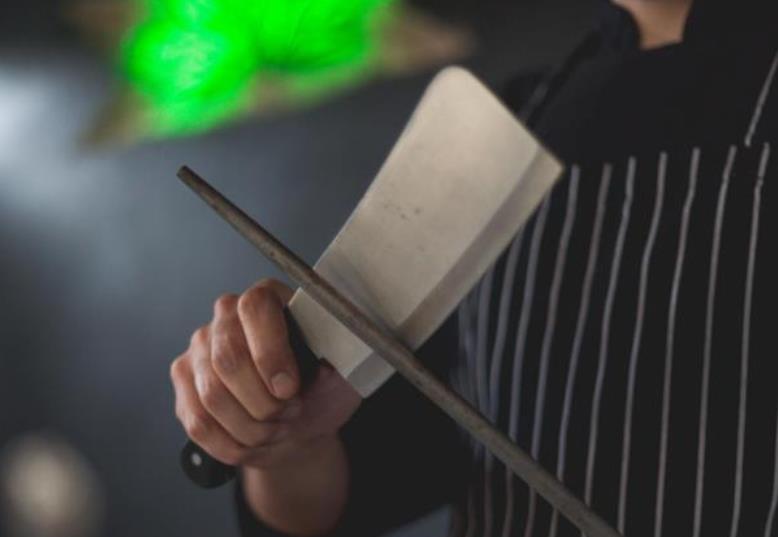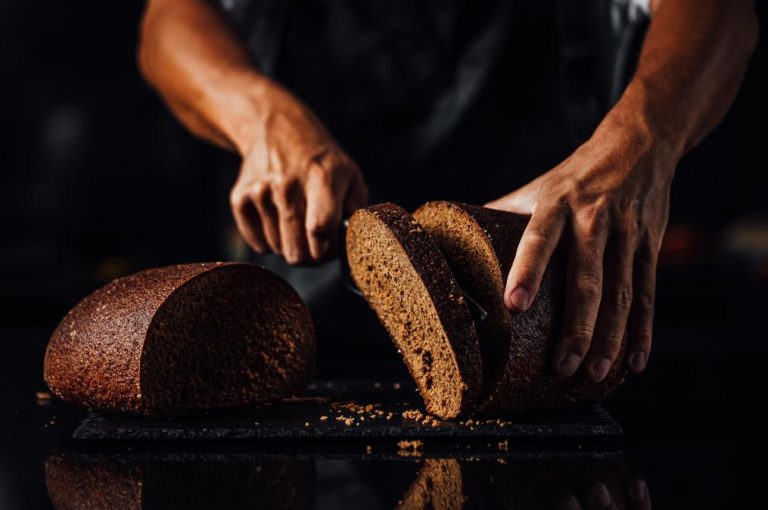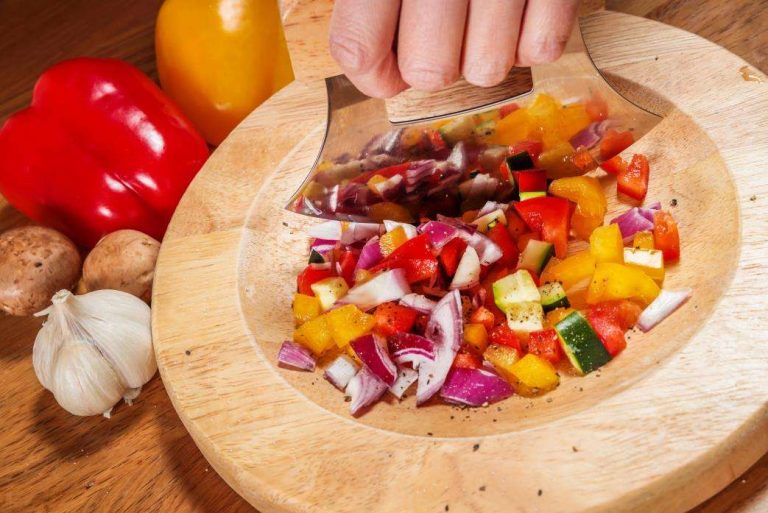An adaptable kitchen knife with an unusual look to western cooks, Chukabocho (Chūkabōchō), translating to “Chinese kitchen knife,” is the equivalent of a chef’s knife to cooks favoring a taller blade.
This Japanese kitchen cutlery comes from cleaver-type Chinese blades, Cai Dao. There are variations to these Chinese-style kitchen knives used for meat, vegetables, and more. There is, however, only one Chukabocho.
In this article, we’ll discuss the features of Chukabocho, look at its uses, and determine if it can benefit your knife store.
After finishing our review of Chukabocho, you can also read about the Chinese cleavers used for food preparation.
Origins of Chukabocho
The many variations of Cai Dao used by Chinese chefs made it attractive to Japanese chefs, who eventually started utilizing them.
However, the differences between Chinese and Japanese cuisine got in the way of Cai Dao being the ideal kitchen cutlery. The Japanese knifemakers took the Cai Dao and forged Chukabocho following traditional forging methods to make it a better fit for Japanese kitchens.
Today, Chukabocho is the most proper kitchen knife for cooks that prefer a rectangular blade. The all-purpose Cai Dao is still a staple in Chinese home kitchens. Many Chinese cooks also prefer the Chukabocho since it’s not so different as it derives from the cleaver-like Chinese kitchen knives.
Chukabocho uses
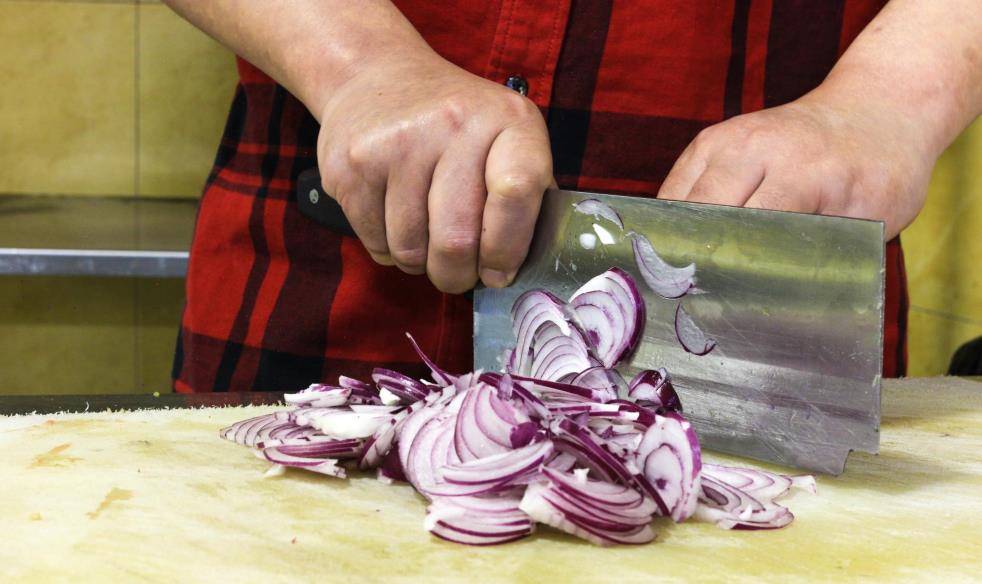
Chukabocho is the knife to pick up for all cutting needs. Cooks familiar with Chukabocho’s blade design, which we’ll get to in a moment, won’t need to look for something else.
Chukabocho is there for slicing vegetables and boneless animal protein, creating uniformed pieces for dishes, and mincing herbs. Any cook expects these basic things from an all-purpose kitchen knife. These aren’t a problem for Chukabocho to handle.
Additionally, the wide blade, identical to a cleaver, also gives the cook some different uses that are impossible to do with the typical chef’s knife. Think tenderizing meats, crushing cloves of garlic and nuts, and scooping everything from the cutting board into the pot at once.
Heel for chopping, tip for slicing
Cooks can utilize Chukabocho best by understanding which part of the blade to use for different tasks. Chukabocho isn’t a specialty knife, so when the cook demands all-purpose from it, using the whole edge is usually unnecessary.
Chukabocho’s heel is sturdier and more comfortable to control when chopping large quantities of vegetables, fruits, or animal protein. The tip is more delicate, making it perfect for slicing.
Furthermore, some cooks even sharpen these two parts of their Chukabocho knives differently. Sharpening the heel similarly to a western chef’s knife makes it more durable for chopping. Keeping the Chukabocho’s tip the same as Japanese Sujihiki or Yanagiba at 10 to 15 grinding angles makes it perfect for finely slicing.
These are just a few ways a cook can get creative with Chukabocho. There is more to its overall design than just the broad blade. Here is how to differentiate Chukabocho from another knife with a similar look.
Buy Wholesale Knives and Start Scaling up with Us Today
Contact us and connect with a sales rep to get a free quote.
Chukabocho knife design
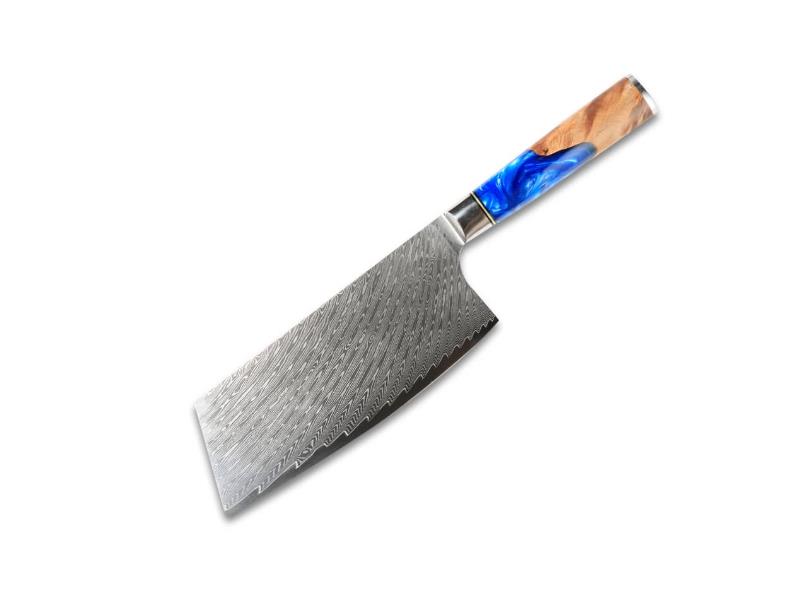
The rectangular blade profile of Chukabocho is hard to miss. It’s the first thing any shopper walking into your store or visiting your online store will notice.
Saying Chukabocho is all about the rectangular, cleaver-like blade profile would be wrong, though. We need to explain every critical part of Chukabocho to understand how it separates itself from other all-purpose kitchen knives.
Bevel
Chukabocho has a double bevel edge. Considering its uses, it’s understandable why knifemakers that developed this knife gave it this type of edge.
Grinding the blade on both sides makes the edge sturdier. Regularly chopping and mincing while making contact with the cutting board can make the edge wear out sooner and promote chipping.
As double bevel knives are more durable, it’s more fitting to Chukabocho. Additionally, all multi-purpose Japanese kitchen knives have this edge type, such as Santoku and Gyuto.
Knife steel
The way cooks utilize Chukabocho also eliminates the traditionally used high carbon steel. The hard carbon steel is susceptible to chipping, particularly under heavy use. Although this isn’t the use case of Chukabocho, knife steel with proper toughness delivers an overall better blade.
Still, there is ideally hard yet durable enough knife steel for Chukabocho. The stainless steel options like AUS-8, AUS-10, VG-10, and SG-2 are excellent for Chukabocho. There are also more affordable options, like ATS-34.
If you’re unsure about picking the right steel, there are also non-Japanese stainless steel alternatives. Upon contacting us, LeeKnives can help you select the appropriate steel for the knife blades you plan to sell.
Blade design

Chukabocho’s blade design is the primary reason it differs from other all-purpose kitchen knives. The rectangular blade design, appearing almost identical to a cleaver, is the main feature of Chukabocho.
Not all Chukabocho kitchen knives are entirely rectangular, though. Knifemakers can choose to alter the design of Chukabocho to give it a pointier tip. Similar to Kiritsuke, these Chukabocho knives follow a triangular tip but in a much steeper direction. The spine’s end and tip are usually less than one inch apart.
This blade design is found in only a handful of Chukabocho. It’s for those who want a Chukabocho with a stabby tip to carve open ingredients easily. Regardless, most Chukabocho has a symmetrical rectangular design without a pointy tip, which can be safer for cooks.
Size
Chukabocho has more mass than a typical kitchen knife. However, despite the identical design, it isn’t as heavy as a cleaver. Being a Japanese kitchen knife, it’s much thinner. The Japanese steel also plays a role in this, as it’s lighter in weight.
Chukabocho has an average blade length of 7 to 10 inches. Even a few millimeters of extra blade can contribute to its weight. This makes Chukabocho vary in weight drastically, from 300 to a hefty 750 grams.
The length of the blade in relation to the weight is one of the critical factors to consider when purchasing a Chukabocho.
A lighter blade is more favorable if your typical customers are regular users. Under prolonged hours of use, a lightweight knife won’t put as much strain on the wrists. A home cook usually doesn’t mind the weight at first, but after getting accustomed to the blade, they may complain about the weight.
Handle
As you can expect, Chukabocho comes with the traditional wa-handle. There are more wa-handle options for Chukabocho than other Japanese-style kitchen knives. It can have the thick, oval wa-handle, D-shaped, or hexagon handle found in blades specializing in delicate slicing.
The handle design of most Chukabocho kitchen knives is usually not entirely straight. They get thinner from the very back (butt) to the bolster.
Knifemakers can choose various materials to build a handle for Chukabocho. The two most popular options are wood and composite. Since it’s a Japanese kitchen knife, these give Chukabocho the standard look buyers favor.
Bolster
The Japanese Chukabocho can have a bolster, but never the full bolster found in western-style kitchen knives. The semi-bolster can be favorable to your customers for several reasons. The bolster is an excellent feature if they want the knife to feel heavier at the handle or give them a sense of security when using it.
One of the Chukabocho knives in our catalog has a bolster, for example. These are more popular among home cooks. For professionals, the bolster isn’t an attractive trait that they seek.
Tang
Chukabocho features a partial tang, like many other Japanese kitchen knives. With others, knifemakers do this to make the knife heavier towards the blade. Regardless of the tang, Chukabocho has a forward balance, thanks to its blade design.
So, Chukabocho’s balance is the same whether it has a partial or full tang. Even if it has a western-style handle with a full tang sandwiched between the handle scales, the knife’s balance won’t change.
Summarizing the features of Chukabocho
- Double bevel edge: Chukabocho has a double bevel edge with an acute grinding angle. This trait of Japanese kitchen knives gives Chukabocho a sharper edge than most other double bevel knives.
- Rectangular shape: Chukabocho has a rectangular blade profile with a generous width. The tall blade contacts the cutting board in its entirety, making it a safe kitchen knife to operate.
- Handle options: Chukabocho usually has the Japanese wa-handle with an oval, hexagonal, or D shape. The preferred handle material is wood, bamboo, or composite wood. Rarely other handle materials are used for Chukabocho, like plastic or bamboo.
- Bolster: Like other all-purpose Japanese kitchen knives, the bolster is optional. If you’re selling to professional chefs or serious cooks, it will be a feature that your buyers won’t require. For home cooks, it’s complementary to have it as the bolster prevents them from sliding their fingers towards the wide, dull part of the blade.
- All-purpose use: Chukabocho’s effectiveness isn’t limited to a handful of tasks. Cooks can utilize it throughout the whole meal preparation without picking up another knife.
Chukabocho vs. Chinese cleaver
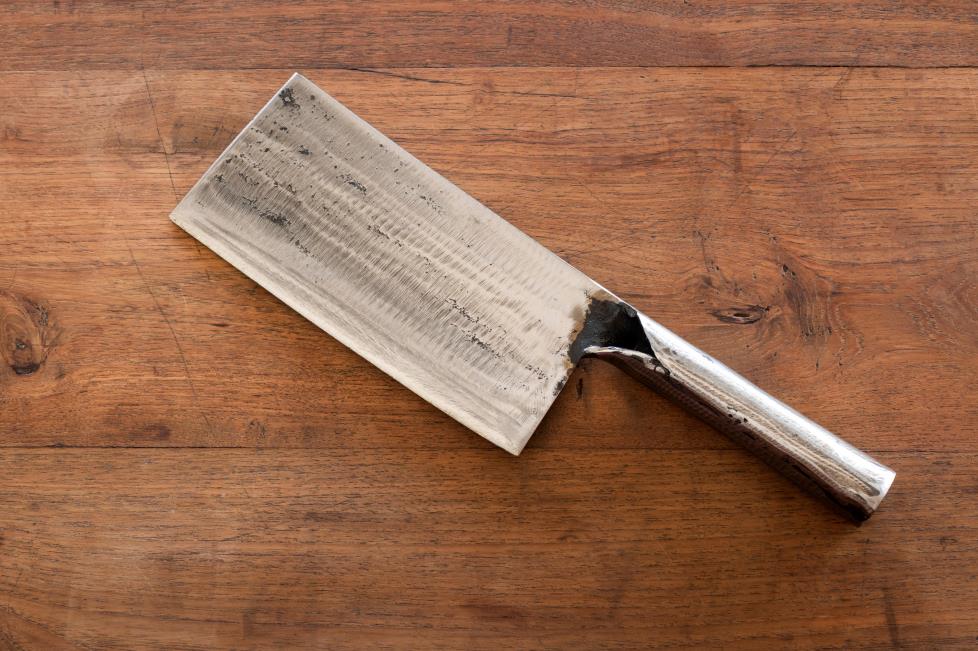
On the surface, there isn’t a difference between the Chinese cleaver (Cai Dao) and Chukabocho. Both the blade and handle are pretty much the same without significant differences. The difference becomes only apparent when a cook picks it up and starts using them.
Steel difference
Chukabocho is made from hard steel to obtain better sharpness and edge retention. This difference in building materials alone makes Chukabocho sharper than the Chinese cleaver.
While Chukabocho is sharper and stays that way for longer, it is less durable. If the cook uses the knife to chop continuously or on large bones, it can chip immediately. It’s best to save Chukabocho for general cooking needs and use the Chinese cleaver for more robust work.
Weight
There’s also the weight. Chukabocho tends to be lighter because of two things: blade thickness and steel – again.
Chukabocho is about two to five millimeters thinner than the Chinese cleavers. Since this means less material, Chukabocho is lighter to hold. The second reason is the lightweight nature of Japanese knife steel.
Manufacturing methods
Chukabocho is almost always forged by hand, as it’s made using Japanese knife steel. Only a handful of stamped Japanese kitchen knives are out there. Even the ones manufactured by stamping don’t perform the same.
Knife brands rarely put stamped Chukabocho as the Japanese knife steel isn’t the ideal material for machining. The Chinese knife steel, even the high-end ones, like 9Cr18MoV, has fair machinability.
This difference in knife steel influences the manufacturing methods, making the Chinese steel and knives better for stamping. Since stamping is cost-effective and perfect for mass production, it’s what most knife manufacturers choose for Chinese cleavers to supply the higher demand.
Chukabocho vs. western meat cleaver
The differences are evident – Chukabocho is a general-purpose kitchen knife, whereas the western meat cleaver is for cutting large bones and slabs of meat.
The tasks a cook performs with Chukabocho won’t be ideal for a western meat cleaver. It’s the same the other way around.
These are two different kitchen tools with purposes of their own. The results won’t be ideal if a cook tries to chop or slice ingredients finely with a western cleaver. It’s no different when trying to cut bones with Chukabocho. The result will be a chipped edge on a ruined blade.
Should you sell Chukabocho in your store?
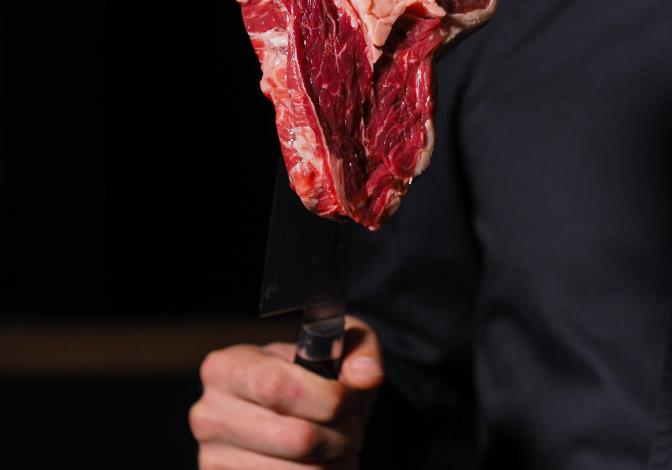
Selling Chukabocho in your knife store is a great idea if you plan on appealing to a wider category of cooks.
However, selling Chukabocho as your main product isn’t the best idea for starters. It’s favored by a handful of users that won’t mind or prefer a tall, heavy-duty blade. Unlike knives of similar looks, Chukabocho will provide the user with a similar utilization as a typical chef’s knife or Gyuto. This can make users turn their heads away from Chukabocho, especially home cooks.
Chukabocho is a type of kitchen knife that attracts enthusiasts with a selection of kitchen knives more than a buyer looking for something to chop tomatoes.
Additionally, the location of your store also matters. Chukabocho is more familiar to Chinese cooks. Because of this, knife shops located in places with a considerable population of Chinese residents, like Panama City and California, are better for selling Chukabocho.
Buy Wholesale Knives and Start Scaling up with Us Today
Contact us and connect with a sales rep to get a free quote.
Brands that succeed in selling Chukabocho
Many Japanese kitchen knife brands that sell premium products have at least one line of Chukabocho. The prominent names, like Kamikoto, Tojiro, Shun, Masamoto, and Sakai Takayuki, have multiple Chukabocho knives.
There are many reasons customers favor these brands. You can create an identical product with LeeKnives through our OEM service. You have the flexibility to modify everything down to the smallest detail, from the steel used to forging methods to other features.
OEM is costlier than buying knives in bulk. Wholesale purchases are better for shops just starting to reduce costs. It’s the same also if you want to test the Chukabocho’s product performance first. If it brings sales, you can always customize Chukabocho to meet your customers’ needs more.
Note: It can take between 25 and 45 days for us to ship your customized Chukabocho for 500 to 2,000 pieces. Learn the other details and specifications for Chukabocho knives in our catalog here.
Selling Chukabocho compared to other multi-purpose knives
There are downsides and upsides to selling Chukabocho compared to other all-purpose kitchen knives.
Chukabocho is not the type of kitchen knife that every cook favors. Your chances of selling one to a home cook looking for a primary kitchen knife to prepare dinners are slim. That’s, at least, compared to a western-style chef’s knife or other Japanese alternatives with a similar build. Not many knife stores sell Chukabocho for this reason.
However, this is also an advantage because your knife store can be one of the few options that can supply a customer who wants one.
Here are a few other pros and cons of selling Chukabocho to give you a better idea.
Pros of selling
- Selling Chukabocho isn’t competitive. Your store can be one of the few places selling Chukabocho to cooks who want one.
- Chukabocho’s versatility is the top reason to sell a knife like this. It can adapt to many kitchen settings, making it a knife for every home and restaurant.
Cons of selling
- It has a lower demand compared to other kitchen knives.
- Chukabocho isn’t the first knife cooks plan to buy when they need an all-purpose kitchen knife.
- There is a learning curve to Chukabocho, where the cook needs to get accustomed to the cutting style and the blade shape.
Chukabocho is an excellent knife that cooks enjoy employing. Don’t let the downsides scare you. It takes an open-minded cook to try Chukabocho once to fall in love with it.
Take a look at our Chukabocho catalog from the link above and contact us with the specifications to get a free quote.
